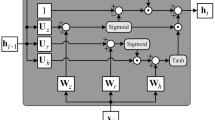Abstract
In this paper a series of recurrent controllers for mobile robots have been developed. The system combines the iterative learning capability of neural controllers and the optimisation ability of particle swarms. In particular, three controllers have been developed: an Exo-sensing, an Ego-sensing and a Composite controller which is the hybrid of the latter two. The task for each controller is to learn to follow a moving target and identify its trajectory using only local information. We show how the learned behaviours of each architecture rely on different sensory representations, although good results are obtained in all cases.
Similar content being viewed by others
References
Beer R (1996) Toward the evolution of dynamical neural networks for minimally cognitive behavior. In: Maes P, Mataric M, Meyer J, Pollack J, Wilson S(eds) From animals to animats 4. MIT, Cambridge, MA, pp 421–429
Beer R (2003) The dynamics of active categorical perception in an evolved model agent. Adapt Behav 11(4): 209–243
Capi G, Doya K (2005) Evolution of neural architecture fitting environmental dynamics. Adapt Behav - Anim Animats Softw Agents Robots Adapt Syst 13(1): 53–66
Clerc M (1999) The swarm and the queen: towards a deterministic and adaptive particle swarm optimization. In Proceedings of the 1999 ICEC, Washington DC, pp 1951–1957
Clerc M, Kennedy J (2002) The particle swarm - explosion, stability, and convergence in amultidimensional complex space. IEEE Trans Evol Comput 6(1): 58–73
De Croon G, Nolfi S, Postma EO (2004) Toward pro-active embodied agents: On the importance of neural mechanisms suitable to process information in time. In: Braha D, Minai A, Bar-Yam Y(eds) Complex engineering systems. Springer Verlag, New York
Eberhart RC, Shi Y (2000) Comparing inertia weights and constriction factors in particle swarm optimization. In: Proceedings of the 2000 congress on evolutionary computation, Washington, DC
Elman JL (1990) Finding structure in time. Cogn Sci 14: 179–211
Fourie PC, Groenwold AA (2002) The particle swarm optimization algorithm in size and shape optimization. Struct Multidisc Optim 23(4): 259–267
Jordan MI (1989) Serial order: a parallel, distributed processing approach. In: Elman JL, Rumelhart DE(eds) Advances in connectionist theory. Erlbaum, Hillsdale
Kennedy J, Eberhart RC (1995) Particle swarm optimisation. In: Proceedings of the IEEE international conference on neural networks, IEEE Service Center, Piscataway, NJ
Nolfi S (2002) Evolving robots able to self-localize in the environment: the importance of viewing cognition as the result of processes occurring at different time scales. Connect Sci 14(3): 231–244
Nolfi S, Marocco D (2002) Active perception: a sensorimotor account of object categorization. In: Hallam B, Floreano D, Hallam J, Hayes G, Meyer J-A(eds) From animals to animats: proceedings of the VII international conference on simulation of adaptive behavior. MIT, Cambridge, MA, pp 266–271
Pugh J, Zhang Y, Martinoli A (2005) Particle swarm optimization for unsupervised robotic learning. In: Swarm Intelligence Symposium, Pasadena, CA, pp 92–99
Slocum A, Downey D, Beer R (2000) Further experiments in the evolution of minimally cognitive behavior: from perceiving affordances to selective attention. In: The sixth international conference on the simulation of adaptive behavior, 11–15 September 2000, MIT, Cambridge, MA, pp 430–439
Tuci E, Harvey I, Quinn M (2002) Evolving integrated controllers for autonomous learning robots using dynamic neural networks. In: Proceedings of the seventh international conference on simulation of adaptive behavior on from animals to animats. MIT, Cambridge, MA
Tuci E, Trianni V, Dorigo M (2004) ‘Feeling’ the flow of time through sensorimotor co-ordination. Connect Sci 16(4): 301–324
Author information
Authors and Affiliations
Corresponding author
Rights and permissions
About this article
Cite this article
McKibbin, S.P., Amavasai, B., Selvan, A.N. et al. Recurrent neural robot controllers: feedback mechanisms for identifying environmental motion dynamics. Artif Intell Rev 27, 113–130 (2007). https://doi.org/10.1007/s10462-008-9087-0
Published:
Issue Date:
DOI: https://doi.org/10.1007/s10462-008-9087-0




